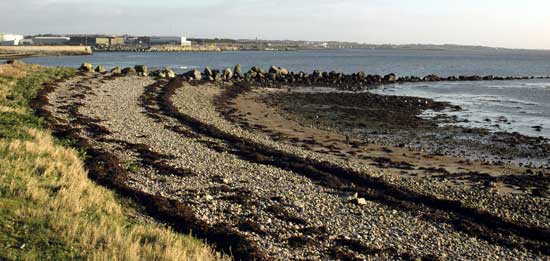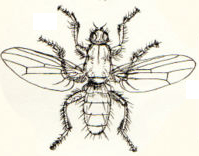Drift seaweed

Drift seaweed accumulates in lines left behind by the receeding tide, as seen above at low tide at the Claddagh in Galway Bay. As the height of the high tide receeds duirng the spring-neap cycle (which happens twice a month) successive lines are left behind. The highest line is that left behind is that of the highest spring tide, although lines may be destroyed by stormy seas. The thoughtful observer can tell which phase of the spring-neap cycle is at by carefully observing the state and dryness of these line of drift seaweed. On wave-exposed western Atlantic coasts much of the drift lines are made of fucoid algae and/or kelps. In more sheltered localities green algae may be more prevalent, particularly where there is a lot of excess nutrients in the water, either from agricultural runoff or from sewage outfalls. In some places, huge amounts of such material accumulate, often necessitating removal, as has happended repeatedly at Worthing on the southe coast of England.
 Seaweed lines are very active habitats with large numbers of sand-hoppers and seaweed flies (Coelopidae) and many birds feed on these during low tides, such as Turnstones. Numbers of seaweed flies are said to exceed a billion per kilometer. Two species of seaweed flies (figured are found in north-eastern Europe (Coelopa frigida and C. pilipes)As the material dries out it is blown up the shore and fertilizes the sand in the uppershore benefitting seaside plants such as Sea Radish and Sea Kale.
Seaweed lines are very active habitats with large numbers of sand-hoppers and seaweed flies (Coelopidae) and many birds feed on these during low tides, such as Turnstones. Numbers of seaweed flies are said to exceed a billion per kilometer. Two species of seaweed flies (figured are found in north-eastern Europe (Coelopa frigida and C. pilipes)As the material dries out it is blown up the shore and fertilizes the sand in the uppershore benefitting seaside plants such as Sea Radish and Sea Kale.
Detached seaweeds sometimes called "total drift" have been used for many years in several European countries, particularly Ireland, for the making of "lazy beds". Soil or sand is layered with seaweed for vegetable production, particularly potatoes. Such organic material has proved very useful in very barren areas, such as the limestone Aran Islands off the mid-west coast of Ireland, and parts of Scotland. On the Aran Islands off the west coast of Ireland,, seaweed and sand was painstakingly transported from the shore to small fields and laid on bare limestone to make "buaile" or small pastures. In the 18th and 19th century land within easy reach of Irish shores was much more valuable than land inland because of the easy access to seaweed.
Seaweed decomposes very slowly and it is probably uneconomical to transport such material more than few kilometers inland. In dry areas or in areas with soils of poor water-retention qualities, seaweed may be very useful as it retains water very well, but there may be problems with the high salt content.
Some specialised uses of drift seaweed are apparent, for example, Breton farmers are said to transport large quantities of the brown alga Himanthalia elongata from the sea for artichoke crops; such uses may be more a matter of tradition than of any great benefit.





